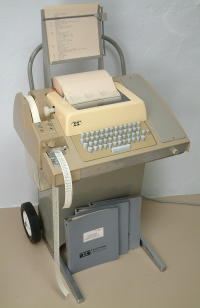| Hardcopy terminal: ASR33 | |
|---|---|
| Rubriek | {{{Rubriek}}}Property "HardwareRubriek" (as page type) with input value "{{{Rubriek}}}" contains invalid characters or is incomplete and therefore can cause unexpected results during a query or annotation process. |
| Fabrikant | 
|
| Model | ASR33 |
| Naam | ASR33 |
| Type | Hardcopy terminal |
| Serial# | |
| Systeem | |
| Architectuur | none |
| Systeembus/interface | |
| OS | none |
| Netwerk | |
| Hostname | none |
| IP Address | none |
| DECnet Address | |
| MAC Address | |
| Collectiegegevens | |
| Eigenaar | Hack42 |
| Status | onbekend |
| Knowhow | typewriters/telex |
| Locatie | Museumhal |
| Label | |
| Herkomst | |
| Datum opname collectie | |
| Bekijk alle hardware - Ga naar het Museum - Nieuw item | |
Teletype Corporation's Model 33 terminal, introduced in 1963, is one of the most popular terminal in the data-communications industry. Over a half-million Model 32's and 33's were made by 1975, and the 500,000th was plated with gold and placed on special exhibit.[3] Another 100,000 were made in the next 18 months, so that No. 600,000 was painted red-white-and-blue and shown around the country during the last part of, and the year after, the Bi-Centennial year.[4]
A Model 33 cost about $700, much less than other teleprinters and computer terminals at the time, such as the Friden Flexowriter and the IBM 1050. Early video terminals, such as the Tektronix 4010, did not become available until 1970 and cost around $10,000. However the introduction of integrated circuits and semiconductor memory later that decade allowed the price of CRT-based terminals to fall below the price of a Teletype. Teletype machines were gradually replaced in new installations by dot-matrix printers and CRT-based terminals in the mid to late 1970s. Basic CRT-based terminals which could only print lines and scroll them are often called glass teletypes to distinguish them from more sophisticated devices.
Teletype Corporation discontinued Model 33 production in 1981
The design objective for the Model 33 was a machine that would fit into a small office space, match with other office equipment of the time and operate up to two hours per day on average. Since this machine was designed for light duty use, adjustments that Teletype made in previous teleprinters by turning screws were made by bending metal bars and levers. Many Model 33 parts were not heat treated and hardened. However, the base was die cast, but self-tapping screws were used, along with parts that snapped together without bolting. In another cost saving measure, the paper tape equipment was dependent on the keyboard and page printer mechanisms. Earlier Teletype machine designs, such as the Model 28 ASR, allowed the user to operate the keyboard to punch tape while transmitting a previously punched tape and to punch a tape while printing something else. Independent use of the paper tape punch and reader is not possible with the Model 33 ASR.[8]
The Model 33 used the seven-bit upper-case only ASCII code, also known as CCITT International Telegraphic Alphabet No. 5, with one (even) parity bit and 2 stop bits. The Model 33 is usually geared to run at maximum speed ten characters per second speed, i.e., 100 words per minute (wpm), but other speeds are available: 60 wpm, 66 wpm, 68.2 wpm, and 75 wpm.[9] There were also many typewheel options. The Teletype Parts Bulletin[10] lists sixty-nine available Model 33 typewheel options.
The Teletype Model 33 contained an answer-back mechanism that was generally used in dial-up networks such as the TWX network. At the beginning of the message, the sending machine could transmit an enquiry character or WRU (Who aRe yoU) code, and the recipient machine would automatically initiate a response which was encoded in a rotating drum that could be programmed by breaking off tabs.[11] The answer-back drum in the recipient machine would rotate and send an unambiguous identifying code to the sender, so the sender could verify connection to the correct recipient. The WRU code could also be sent at the end of the message. A correct response would confirm that the connection had remained unbroken during the message transmission. Finally, the sending machine operator would press the disconnect button. Note that the receiving machine did not need operator intervention. Since messages were often sent across multiple time zones to their destination, it was common to send a message to a location where the receiving machine was operating in an office that was closed and unmanned.
The Teletype Model 33, including the stand, is 34 inches high, 22 inches wide and 18.5 inches deep, not including the paper holder. The Teletype Model 33 weighs 75 pounds on the stand, including paper. This machine requires less than 4 amperes at 115 VAC 60 Hz. The recommended operating environment is a temperature of 40 °F to 110 °F, a relative humidity of 2 to 95 percent and an altitude of 0 to 10,000 feet. The printing paper is a 8.44 inch by 4.5 inch diameter roll and the paper tape is a one inch by 1000 foot roll. Ribbons are 0.5 inch wide by 60 yards long with plastic spools and eyelets for proper ribbon reverse operation.
